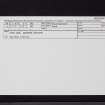Luce Bay, Airship Station
Airship Station (First World War)
Site Name Luce Bay, Airship Station
Classification Airship Station (First World War)
Canmore ID 61274
Site Number NX15NW 56
NGR NX 1125 5518
NGR Description NX c. 1125 5518
Datum OSGB36 - NGR
Permalink http://canmore.org.uk/site/61274
- Council Dumfries And Galloway
- Parish Inch
- Former Region Dumfries And Galloway
- Former District Wigtown
- Former County Wigtownshire
Luce Bay military airship station was established in 1915 as part of a network of airship stations to patrol the North Channel and the Irish Sea for enemy submarines – an increasing threat as the war went on. In the 1918 RAF survey of air stations Luce Bay was described as ‘Non-rigid Airship Patrol Station (NW Area, No. 25 Operation Group”, and the “parent” station of sub-stations at Ramsay (Isle of Man), Machrahanish, Larne (Co Antrim) and Ballyliffon (Doagh Island, Northern Ireland).
The aerodrome occupied an area of about 180 hectares, measuring a maximum of 2075m by 1400m. The station’s buildings were concentrated along the western boundary of the aerodrome, apart from the enormous airship shed and its ancillary plant (such as the gas plant and a 283 cubic metre storage tank). The establishment of the station (250 personnel, of whom 37 were women) was accommodated on site.
The airship shed, measuring 92m by 21m by 15m high, was almost completed by June 1915, at a cost of £8900 (£865,000 at 2013 prices); the wind-breaks at both ends cost a further £4200 (£408,000).
A maximum of four airships was based at Luce Bay. In 1918 fixed-wing aircraft were added to the patrol strength at Luce Bay. Three Bessonneau canvas hangars were erected to the north of the accommodation site, but also on the western boundary of the station.
The station closed soon after the war and the airship shed was sold off and dismantled. The area of the airship station was incorporated into the Second World War West Freugh aerodrome.
Information HS/RCAHMS World War One Audit Project (GJB) 31 May 2013
NX15NW 56 c. 1125 5518
c. NX 117 597. Luce Bay airship station was established in 1915-16 as an element of the strategic network protecting the British coastline; it was equipped with three or four 'Sea Scout' non-rigid craft as well as a number of kite balloons which were intended to be towed behind ships. The shed that was intended to house these smaller craft at Luce Bay measured 302 ft (92.05m) in length by 70 ft (21.34m) in width and 50 ft (15.24m) high.
G D Hay and G P Stell 1986.
Luce Bay is at c. NX 117 537. The exact location for the airship station can be ascertained from National Archive (Public Record Office AIR/1/453/15/312/26 Vol. VI), plan of the site (MS 879/63). The domestic and oter accommodation was at NX 1125 5518, imemdiately E of the track that led to East Freugh farmsteading.
It was situated 200m SW of East Freugh farmsteading, which was demolished when Freugh Airfield was built. The airship shed was at NX 1144 5517, some 300m SE of the farmsteading.
Information from RCAHMS (DE), July 2006; MS 879/63/3
Project (March 2013 - September 2013)
A project to characterise the quantity and quality of the Scottish resource of known surviving remains of the First World War. Carried out in partnership between Historic Scotland and RCAHMS.








